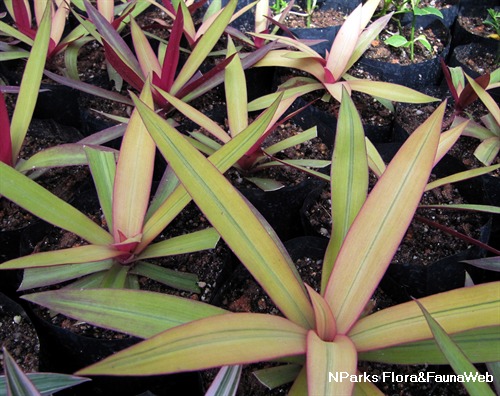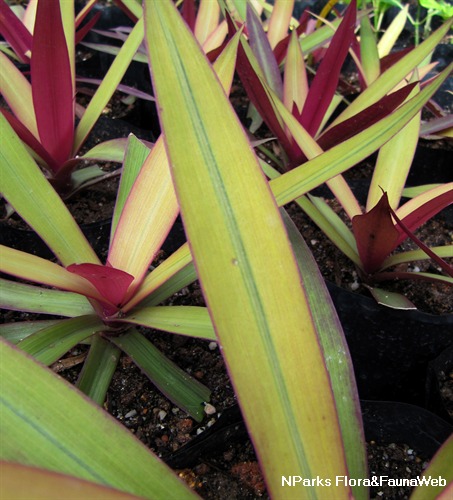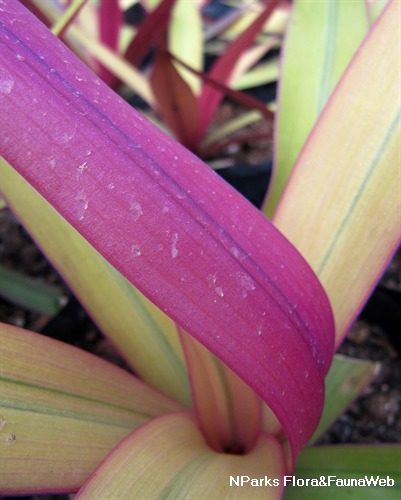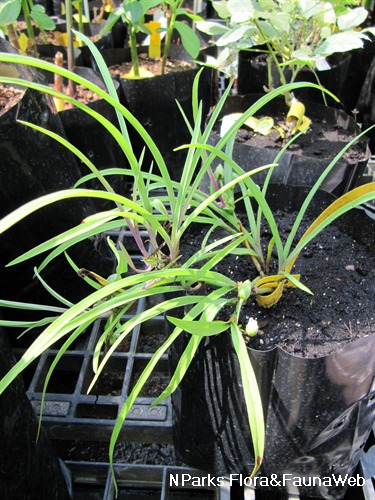
Back
Tradescantia spathacea 'Sitara Gold'
| Family Name: | Commelinaceae |
| Common Name: | Oyster Plant, Boat Lily |
Name
Classifications and Characteristics
| Plant Division | Angiosperms (Flowering Seed Plants) (Monocotyledon) |
|---|---|
| Plant Growth Form | Herbaceous Plant |
| Lifespan (in Singapore) | Perennial |
| Mode of Nutrition | Autotrophic |
Biogeography
| Native Distribution | Of horticultural origin |
|---|---|
| Preferred Climate Zone | Tropical |
| Local Conservation Status | Non-native |
Description and Ethnobotany
| Growth Form | It is a herbaceous plant growing in a clump-forming rosette form and grows about 15 to 30 cm tall. |
|---|---|
| Foliage | Its leaves are sword-shaped. The leaf upper side is coppery-gold while the underside is purple to burgundy. |
Landscaping Features
| Desirable Plant Features | Ornamental Foliage, Ornamental Form |
|---|---|
| Landscape Uses | Parks & Gardens, Flowerbed / Border, Groundcover, Container Planting |
| Thematic Landscaping | Rockery / Desert Garden |
| Usage Hazard - Cons | Irritant - Sap |
Plant Care and Propagation
| Light Preference | Full Sun, Semi-Shade |
|---|---|
| Water Preference | Moderate Water |
| Plant Growth Rate | Fast |
| Rootzone Tolerance | Drought Tolerant, Well-Drained Soils, Fertile Loamy Soils, Shallow Media, Easy to Grow |
| Maintenance Requirements | Moderate |
| Potential Problems | Over-watering may cause root rot. |
| Propagation Method | Storage Organ, Division |
Foliar
| Foliage Retention | Evergreen |
|---|---|
| Mature Foliage Texture(s) | Smooth, Thick |
| Foliar Type | Simple / Unifoliate |
| Foliar Arrangement Along Stem | Whorled |
| Foliar Venation | Parallel |
| Foliar Margin | Entire |
| Foliar Apex - Tip | Acute |
| Foliar Base | Truncate / Square |
| Mature Foliage Colour(s) Remarks | Top side of leaf is yellowish green, under side of leaf is purple. |
Non - Foliar and Storage
| Stem Type & Modification | Herbaceous |
|---|
Floral (Angiosperm)
| Flower & Plant Sexuality | Bisexual Flowers |
Image Repository
Others
| Master ID | 32050 |
|---|---|
| Species ID | 6455 |
| Flora Disclaimer | The information in this website has been compiled from reliable sources, such as reference works on medicinal plants. It is not a substitute for medical advice or treatment and NParks does not purport to provide any medical advice. Readers should always consult his/her physician before using or consuming a plant for medicinal purposes. |







